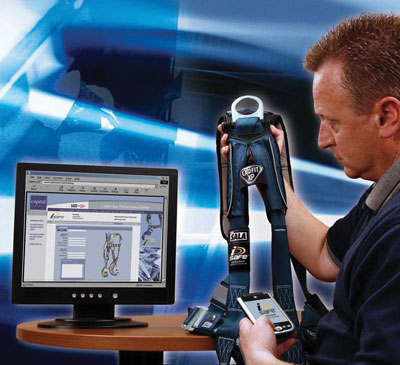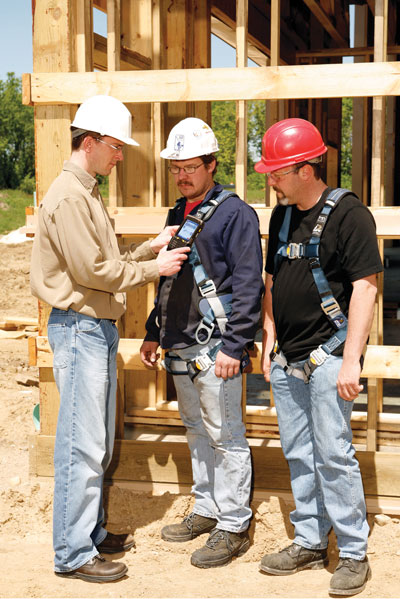
Technology
Machinery
Safety gear that talks
RFID systems can make your safety protocols work better.
March 29, 2012 By Shari Kowalke Capital Safety
Radio frequency identification technology has existed for years
Radio frequency identification technology has existed for years, and though most have heard of it, there is still a great deal of confusion about how the technology is used in conjunction with fall protection equipment.
 |
|
| RFID tags can be linked to a web portal that offers manuals, inspection checklists, training records, industry regulations, product advisories and other useful tools. Users can increase safety, prove compliance and save time. (Photo courtesy of Capital Safety)
|
RFID improves efficiency when tracking and logging safety equipment. It also streamlines and standardizes the process. Recent estimates show that companies employing RFID technology can achieve between 35 and 50 per cent improvement in time-savings when using RFID over a pencil-and-paper recording system. RFID tracking systems facilitate tracking of safety equipment and management of safety inspection programs, including electronic inspection records rather than handwritten notes, thereby promoting the safety of workers who use the equipment.
How does RFID work?
RFID technology uses radio waves to transmit data from identification tags on a piece of equipment to a handheld device for the purpose of automatic identification and tracking. An RFID tag or marker is attached to a piece of equipment, giving that item a unique identifier.
A handheld transceiver communicates with a tag’s built-in antenna, enabling it to read the code using radio waves before storing the information in a database. This allows the device’s user to easily see where pieces of fall protection equipment are located in real time, and what working condition they are in.
Most RFID tags used in conjunction with fall protection equipment are classified as passive, meaning they require no battery and are powered only by the radio waves used to read them. To activate the tag, a handheld reader is simply held near the RFID tag, which is most often embedded within the tracked object itself.
There are three main frequencies that RFID systems use: low, high, and ultrahigh. Generally speaking, a higher frequency means faster data transfer and a longer read range. However, higher frequencies are also more sensitive to interference from environmental factors, such as metal and liquid. Each frequency has its advantages and disadvantages, and no single frequency is ideal for all situations.
The history of RFID
RFID technology has been around since the 1970s when it was used to track larger assets, such as nuclear missiles, shipping containers, and even cows. These original tags were large and bulky, made of metal coils, antennae and glass. Over time, the technology was commercialized, making it more affordable for everyday use. In the 1990s, RFID evolved from being just a mobile database into a network tool by adding the ability to link objects to the Internet through the tag.
Today, the application of RFID technology has expanded to nearly every market. RFID can be found in everything from automated toll collection systems to building access control to management of safety equipment (which we will discuss in more depth below). Some say RFID applications are limited only by people’s imaginations.
What are the benefits of using RFID?
Most importantly, RFID systems improve worker safety. Tracking and reporting is an often-overlooked aspect of fall protection, but ensuring that equipment is regularly checked and approved for use is critical to worker safety. RFID ensures that the equipment each worker receives is compliant with all applicable safety standards and regulations and has been inspected on schedule.
Another benefit of using an RFID system is on-site material asset management. A typical RFID technology system for fall protection equipment comprises RFID tags, PDA readers and a web portal.
Each RFID tag is programmed with a unique ID that registers the model type and history of the equipment it is linked to. The passive tag transmits a variety of coded information to the PDA, which displays the product make and model and inspection records, in addition to jobsite and worker assignment. This data is linked to a personalized web portal that can provide further information, including user manuals, inspection checklists, training records, industry regulations, product advisories and other useful tools. By tracking use and status, inventory management is greatly improved, ensuring that required equipment is available when and where it is needed.
RFID also aids in the management of safety inspection data. By electronically storing information, inspection records usually filed away can be provided at a moment’s notice when inspections occur.
Since there is no downtime while managers search for records, no working time is lost and productivity remains high.
Not only does RFID technology simplify the process of tracking and checking inventory, but it also saves companies time, money and stress.
Many fall protection manufacturers are embracing the RFID trend and a great deal of equipment now comes embedded with an RFID chip as a standard feature. This is something to consider when investigating and purchasing fall protection equipment – is the equipment ready to be used with an RFID system immediately? As mentioned earlier, fall protection equipment embedded with RFID technology makes managing a safety program easier and more cost-effective.
If a piece of fall protection equipment does not have an embedded RFID tag, and was produced before this technology was available, retrofitting kits can help. Retrofitting kits are widely available for all types of equipment, regardless of brand, to extend the benefits of RFID technology to an existing inventory. To start electronic record keeping with a retrofitting kit, the tag is simply attached to the piece of equipment and the user is prompted to enter the model number, make and date of manufacture.
At the click of a mouse, RFID technology enables equipment tracking, equipment compliance and, most importantly, worker safety. With all the benefits RFID provides, it’s no wonder most fall protection manufacturers are choosing to embed RFID tags in standard equipment and develop their own RFID safety systems. Once companies start using RFID systems for fall protection equipment, it’s hard to imagine going back.
What to consider
RFIDWhen searching for an RFID technology system to track and check fall protection equipment, there are many factors to consider. To get the most out of your system, look for:
|
Shari Kowalke is the I-Safe sales specialist with Capital Safety. She can be reached at skowalke@capitalsafety.com. Capital Safety is a leading designer and manufacturer of height safety and fall protection equipment under the DBI-SALA, Protecta and Uniline brands. Capital Safety offers fall protection and rescue systems, as well as training courses. For more information, contact Capital Safety at 800-328-6146 or visit www.capitalsafety.com
Print this page

Leave a Reply